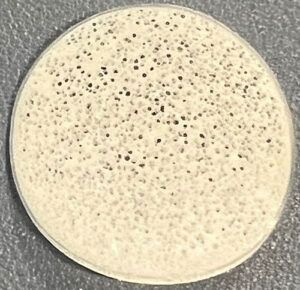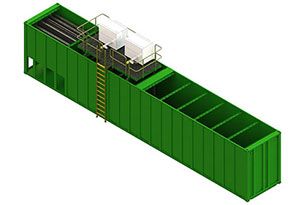Summary
For industrial plant operators, EHS managers, and engineers, maintaining compliance with wastewater discharge regulations is a critical, ongoing challenge.1 Many facilities operate with aging and outdated activated sludge systems that struggle to meet today's stringent requirements.2 This article explores the benefits of retrofitting these older systems with advanced Moving Bed Biofilm Reactor (MBBR) and Integrated Fixed-Film Activated Sludge (IFAS) technologies from Ecologix Environmental Systems. By upgrading, plants can significantly improve treatment capacity, handle higher biochemical oxygen demand (BOD) and chemical oxygen demand (COD) concentrations, save valuable space and money, and ensure long-term regulatory compliance.
Table of Contents
- Introduction: The Need for Modernization
- Core Content: Understanding MBBR and IFAS
- Moving Bed Biofilm Reactor (MBBR)
- Integrated Fixed-Film Activated Sludge (IFAS)
- Key Differences
- Challenges of Outdated Systems
- Solutions: The Advantages of Retrofitting
- Increased Treatment Capacity
- Enhanced BOD/COD Removal
- Space and Cost Savings
- Process Stability and Reliability
- Conclusion: A Strategic Investment
- Glossary
- Frequently Asked Questions (FAQ)
- Bibliography
1. Introduction: The Need for Modernization
Many industrial facilities rely on conventional activated sludge systems for wastewater treatment. While these systems have been a workhorse for decades, they often face challenges in today's demanding operational environment. Stricter environmental regulations, increased production, and higher organic loads can push these older systems beyond their capacity, leading to non-compliance, costly fines, and potential shutdowns.3 Retrofitting with Ecologix MBBR or IFAS technology offers a cost-effective and efficient solution to these challenges, breathing new life into existing infrastructure.4
2. Core Content: Understanding MBBR and IFAS
Moving Bed Biofilm Reactor (MBBR)
The Ecologix MBBR system is a biological treatment process that utilizes a combination of conventional activated sludge and biofilm media.5 The key to the MBBR process is the use of floating, high-capacity microorganism media within the aeration and anoxic tanks, called "Eco Chips".6 These Eco Chips provide a massive surface area for microorganisms to attach and grow, creating a robust biofilm that efficiently consumes organic material in the wastewater.7
- How it Works: The Eco Chips are kept in constant motion by the aeration system, ensuring optimal contact between the wastewater, the biofilm, and dissolved oxygen.8 This high-density biomass concentration allows for a significant increase in treatment capacity within the existing tank volume.9

Integrated Fixed-Film Activated Sludge (IFAS)
The IFAS process is a hybrid technology that integrates the benefits of both attached growth (biofilm) and suspended growth (activated sludge) systems within the same reactor.11 Similar to MBBR, IFAS utilizes biofilm carriers to enhance the microbial population, but it also maintains a mixed liquor suspended solids (MLSS) concentration, as in a conventional activated sludge system.12
- How it Works: The IFAS process integrates the benefits of both biofilm and activated sludge systems within the same reactor.13 By combining these two approaches, IFAS can achieve even higher levels of treatment
Key Differences
| Feature | MBBR | IFAS |
|---|---|---|
| Primary Growth Type | Attached Growth (Biofilm) | Hybrid (Attached and Suspended Growth) |
| Return Activated Sludge (RAS) | Not Required | Required |
| Best For | High BOD/COD removal | BOD/COD and nutrient removal (nitrification/denitrification) |
| Complexity | Simpler operation | Slightly more complex due to RAS management |
3. Challenges of Outdated Systems
Aging activated sludge systems present a number of challenges for plant operators:
- Limited Treatment Capacity: Difficulty handling increased wastewater flows or higher organic loads.
- Poor Sludge Settling: Issues with sludge bulking and high effluent suspended solids.
- Inconsistent Performance: Susceptibility to shock loads and fluctuations in wastewater characteristics.
- Large Footprint: Requires significant land area for treatment basins.
- High Operational Costs: High energy consumption for aeration and sludge handling.
4. Solutions: The Advantages of Retrofitting
Upgrading to an Ecologix MBBR or IFAS system addresses the challenges of outdated systems head-on:
Increased Treatment Capacity
- Treat higher volumes of wastewater.
- Handle increased organic loads without expanding the plant's footprint.
- Accommodate future production increases.
Space and Cost Savings
- Treat higher volumes of wastewater.
- Capital Costs: Utilizes existing tanks and infrastructure, reducing construction costs.15
- Operational Costs: Optimized aeration and reduced sludge production lead to lower energy and disposal costs.16
- Footprint: Increased treatment capacity in the same or smaller footprint, freeing up valuable plant space.
Process Stability and Reliability
The attached-growth biofilm in MBBR and IFAS systems is more resilient to process upsets than suspended-growth systems.
- Shock Load Resistance: The biofilm provides a stable microbial population that can withstand fluctuations in influent quality.17
- Improved Sludge Settling: The biofilm carriers can help to improve the settling characteristics of the sludge.18
- Simplified Operation: The self-regulating nature of the biofilm reduces the need for constant operator intervention.19
5. Conclusion: A Strategic Investment
For industrial facilities facing the challenges of aging wastewater treatment infrastructure, retrofitting with Ecologix MBBR or IFAS technology is a strategic investment in the future. These advanced systems offer a proven and cost-effective way to increase treatment capacity, improve performance, and ensure long-term compliance with environmental regulations.20 By modernizing their wastewater treatment operations, plants can not only protect the environment but also enhance their operational efficiency and profitability.21
6. Glossary
- BOD (Biochemical Oxygen Demand) A measure of the amount of dissolved oxygen required by aerobic biological organisms to break down organic material present in a given water sample.22
- COD (Chemical Oxygen Demand): A measure of the capacity of water to consume oxygen during the decomposition of organic matter and the oxidation of inorganic chemicals.23
- EHS: Environment, Health, and Safety.
- IFAS (Integrated Fixed-Film Activated Sludge): A hybrid wastewater treatment process that combines attached-growth and suspended-growth systems.24
- MBBR (Moving Bed Biofilm Reactor): A biological wastewater treatment process that uses biofilm carriers to increase the microbial population.25
- MLSS (Mixed Liquor Suspended Solids): The concentration of suspended solids in the mixed liquor of an activated sludge system.26
- RAS (Return Activated Sludge): The settled activated sludge that is returned to the aeration tank to maintain the desired concentration of microorganisms.
7. Frequently Asked Questions (FAQ)
- What is the lifespan of the Ecologix Eco Chips?
- The Eco Chips are made from durable, high-density polyethylene (HDPE) and are designed to last for many years with minimal maintenance.27
- Can MBBR and IFAS systems be used for nutrient removal?
- Yes, both systems can be configured for biological nutrient removal, including nitrification and denitrification.28 IFAS is particularly well-suited for this application.
- How much downtime is required to retrofit an existing system?
- Ecologix works to minimize downtime during the retrofitting process. The exact timeline will depend on the specific project, but the use of existing tanks significantly reduces the installation time compared to building a new system.
- What industries can benefit from MBBR and IFAS technology?
- These systems are highly effective for a wide range of industries, including pulp and paper, food and beverage, chemical manufacturing, and municipal wastewater treatment.
8. Bibliography
- Moving-bed biofilm reactor. Wikipedia. https://en.wikipedia.org/wiki/Moving-bed_biofilm_reactor
- Performance of Integrated Fixed-Film Activated Sludge (IFAS) under Variable Organic Load. Avestia Publishing. https://avestia.com/CSEE2021_Proceedings/files/paper/ICEPTP/ICEPTP_108.pdf
- Compact Technology: Increasing Treatment Capacity Without Building More Basins. Florida Water Resources Journal. http://fwrj.com/techarticles/0709tech2.pdf
- Ecologix Environmental Systems. https://ecologixsystems.com
Ready to Optimize Your Water Treatment?
Connect with Ecologix Systems today to discuss your project.
Contact us today